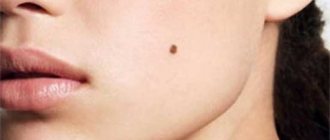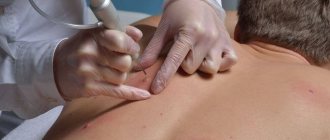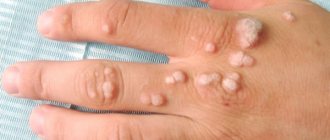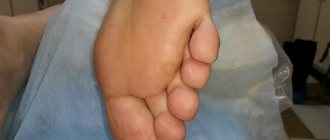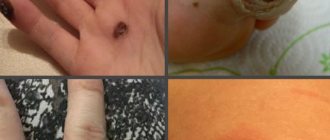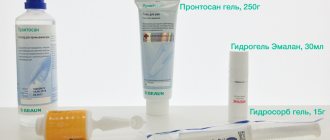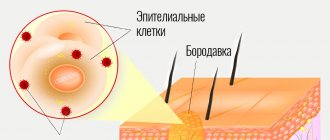For example, electroagulation destroys a wart or papilloma using electric current. Cryodestruction destroys tumors using extreme low temperatures. Today, laser removal of tumors is the most effective and safe method without the risk of complications. This is explained by the fact that the laser has high accuracy. Laser is a strong antiseptic; it ensures sterility and active restoration of cells and tissues. The impact of the laser is dosed.
Laser removal of tumors allows you to remove all benign growths (moles, papillomas, etc.)
The laser “evaporates” tissue due to the high temperature and power of the beam. In this case, the doctor fully controls the depth of the laser’s impact on the tumor.
After removing the formation with a laser
After we have removed your mole or other formation with a laser, we treat it with a fucorcin solution, seal it, and you need to treat it at home with a fucorcin solution for 4 days. Twice a day - treat and seal with any bactericidal plaster.
Within 7 days after laser removal of skin lesions, a scab or crust forms, which protects the wound from external influences - sun, dirt, mechanical stress, etc. Under the crust, the wound will heal and regenerate itself. It is not advisable to wet the wound for a week. If it gets wet, it’s okay, you can dry it and also treat it with a solution of fucorcin or another antiseptic.
For 2 weeks after removal of the formation, it is not recommended to visit the bathhouse, sauna, or swimming pool.
It is not advisable to sunbathe or visit a solarium for a month so that pigment does not form in the area of removal.
For 2 months after removal, when exposed to the sun or tanning, it should be treated with a product with SPF 50+ or covered with a bactericidal patch.
Possible consequences of the operation
Sometimes the healing process occurs with various deviations from the norm, which can occur regardless of how carefully the preventive requirements are followed. This may include the following:
- Nevus recurrence (re-formation of a mole). This situation is possible if during the operation the mole was not completely removed, and a small amount of nevus particles remained on the skin. Gradually, the cellular tissue grows, and the mole forms again. This does not pose a health risk, but in the future you will have to undergo the removal procedure again.
- Hypopigmentation is the formation of a white spot at the site of removal. This cosmetic defect occurs after removal of a deep-lying tumor. Hypopigmentation also occurs when exposed to sunlight. A white spot on the skin usually goes away on its own, but it takes at least a year.
- A hypotrophic scar is a scar at the site of a removed mole, the cause of which is the low rate of tissue restoration. This is usually a shallow defect, and over time the scar tissue smoothes out on its own.
- A hypertrophic scar is a small bump at the site of a removed mole, usually darker in color than the surrounding skin. The defect may go away on its own, or the doctor will prescribe additional cosmetic procedures that smooth the skin.
After surgical removal of the formation
When the formation is removed using a scalpel, an incision is made and a cosmetic suture is applied; in this case, no special care is required either. Usually we stick on strips, under which the wound heals itself and you come to us on the seventh day to remove the stitches. If you get these strips wet, it is advisable to dry them and treat them with an alcohol solution or chlorhexidine.
If the wound after removal is large or located on the scalp, we treat such places with either iodine solution, betadine, or fucorcin so that a secondary infection does not join the wound.
Prevention of scars at the site of nevus
In most cases, the risk of skin scarring depends on the method used to perform the excision surgery. The highest probability of such an outcome after use:
- acids;
- cryodestructive method (liquid nitrogen);
- if surgical excision with a scalpel is performed.
Least likely when using coagulators. These include:
- high temperature laser;
- radio wave method (radio knife, or better known name Surgitron);
- electric shock method (known as electrocoagulation or electric knife).
Speedy healing ensures proper care of the painful area. If a suture is applied, it must be removed in a timely manner. Regular dressings, the use of special creams, and ensuring the integrity of the surface will help protect against the growth of connective tissue.
Proper adherence to all recommendations for wound care after removal of a birthmark will prevent the likelihood of complications, and the healing process will be more effective.
In what cases should you consult a doctor again?
When serous or purulent discharge, odor, redness, pain appear from the wound - such situations can occasionally occur within 7 days. You need to see a doctor about this. After the examination, the doctor will give recommendations for further care.
After the first month, when the scar has formed, it is most often normotrophic - neat and already similar to the color of the skin. But sometimes a trophic, hypertrophic or keloid scar can form. Such a scar can be corrected by a surgeon or contact a cosmetologist who can also help with this.
+7 (495) 255−50−11.
What determines the risk of scarring?
The appearance of a scar and its nature depends on a number of factors:
- Depth and area of damage: if they are small, a scar may not appear at all.
- Tissue healing abilities.
- The presence of chronic diseases (for example, diabetes).
- Time for complete healing of the wound (it may increase if the wound has become infected).
The process of complete wound healing, which lasts for 21 days, ends with pathological scarring in only 33% of cases. If the process lasts more than 21 days, the probability increases to 78%.
Prices:
Prices for removal of formations
| Consultation with a dermato-oncologist surgeon | FOR FREE |
| Dermatoscopy: | |
| - for all education | 500 rub. |
| Skin mapping: | |
| 1-3 formations | 500 rub. |
| 4-10 formations | 2,000 rub. |
| 11-25 formations | 4,000 rub. |
| 26-50 formations | 6,000 rub. |
| Histological examination: | |
| Histology Dialab | 1,500 rub. |
| Histology Hemotest | 3,000 rub. |
| Revision of glasses by expert morphologist Prof. Mordovtseva V.V. | 6,000 rub. |
| Local anesthesia: | |
| - injection | 300 rub. |
| - cream | 300 rub. |
| Laser removal of 1 formation on the skin: | |
| diameter: | |
| - up to 1 mm | 100 rub. |
| - up to 2 mm | 400 rub. |
| - up to 3 mm | 600 rub. |
| - up to 4 mm | 700 rub. |
| — up to 5 mm | 800 rub. |
| - up to 6 mm | 900 rub. |
| - up to 7 mm | 1,000 rub. |
| - up to 8 mm | 1,100 rub. |
| - up to 9 mm | 1,200 rub. |
| - up to 10 mm | 1,300 rub. |
| Laser removal of 1 formation on the skin of the eyelids, mucous membranes, plantar and periungual: | |
| - up to 1 mm | 300 rub. |
| - up to 2 mm | 400 rub. |
| - up to 3 mm | 700 rub. |
| - up to 4 mm | 800 rub. |
| — up to 5 mm | 900 rub. |
| - up to 6 mm | 1,000 rub. |
| - up to 7 mm | 1,100 rub. |
| - up to 8 mm | 1,200 rub. |
| - up to 9 mm | 1,300 rub. |
| - up to 10 mm | 1,400 rub. |
| Chalazion removal | 7,000 rub. |
| Laser removal of 1 formation on the ciliary edge of the eyelids: | |
| - up to 1 mm | 500 rub. |
| - up to 2 mm | 1,000 rub. |
| - up to 3 mm | 1,500 rub. |
| - up to 4 mm | 2,000 rub. |
| — up to 5 mm | 2,500 rub. |
| Excision of formations with suturing: | |
| Excision of formations with 5 mm sutures on the body | 1,500 rub. |
| Excision of formations with sutures on the face M-zone (cheeks, forehead, chin, temple, scalp) - 5 mm | 2,500 rub. |
| Excision of formations with sutures on the face H-zone (nose, eyelids, lips, ears) - 5 mm | 5,000 rub. |
| Excision of formations with 5 mm sutures on the hands and feet | 2,500 rub. |
| Excision of formations using the Mohs method + cost of wound closure: | 30,000 rub. |
| on the face M-zone (cheeks, forehead, chin, temple, scalp) - 5 mm | 2,500 rub. |
| on the face H-zone (nose, eyelids, lips, ears) - 5 mm | 5,000 rub. |
| Removal of molluscum contagiosum in children under 10 years of age: | |
| - for one education | 300 rub. |
| Laser correction of ingrown toenails (one side of the nail): | |
| Laser correction with removal of the growth zone | 3,500 rub. |
| Resection of an ingrown nail without removing the growth zone | 1,900 rub. |
| Removing the thumbnail | 1,700 rub. |
| Removal of the nail on the 2nd to 5th finger | 1,000 rub. |
| Earlobe correction: | |
| — After earrings (for 1 side) | 3,000-6,000 rub. |
| — Correction of the shape of the lobes, including tunnels (for 1 side) | 10,000 rub. |
| Excision of scars (per 1 cm incision): | |
| Excision of scars on the body, 1 cm of scar | 3,000 rub. |
| Excision of scars on the face and neck, 1 cm of scar | 5,000 rub. |
| Correction of body scar with local tissues, 1 cm of scar | 5,000 rub. |
| Correction of face and neck scars with local tissues, 1 cm of scar | 10,000 rub. |
| Correction of retracted scars with Collost filler 7% - 1.5 ml | 13,000 rub. |
| Correction of retracted scars with Collost filler 15% - 1.5 ml | 18,000 rub. |
| Collost micro – 150 mg | 20,000 rub. |
| Spherogel Lights 0.5 ml | 7,000 rub. |
| Spherogel Lights 1.0 ml | 12,000 rub. |
| Spherogel Medium 0.5 ml | 9,000 rub. |
| Spherogel Medium 1.0 ml | 16,000 rub. |
| Scar hormone therapy (Diprospan) | 1,300 rub. |
| Laser resurfacing CO2 1 cm2 | 2,000 rub. |
| Biopolymer removal | 40,000 rub. |
Seals under a mole, is it dangerous?
Often, if you have a mole (nevus), you can see a small lump located somewhere around the mole or just below. No one can say whether they are dangerous or not without proper inspection. Only after specialists have seen, touched and examined can we talk about the results and the degree of their danger. In most cases, such seals do not pose any danger. But there are many exceptions. Only a specialist will be able to draw the correct conclusion.
Is it necessary to remove a nevus with compaction?
By their nature, ordinary nevi do not pose any threat. If they are symmetrical, do not increase in size, do not change color, do not bleed, do not crack or cause anxiety, there is no need to remove them. Whether they are with or without a seal does not matter at all, the main thing is that they do not change and do not cause discomfort (except for aesthetic reasons, of course). It is better to consult a doctor to calm your nerves, but usually they do not pose any danger, but simply exist as an integral part of the human body.
What to do after radical removal of melanoma?
After therapy is completed, doctors will continue to monitor the patient closely. Along with the risk of recurrence of melanoma, other complications may occur. Postoperative monitoring of the patient's condition will include:
- regular examination of the skin and the condition of the lymph nodes - independently and by a doctor;
- depending on the stage of the disease, control instrumental studies (X-ray, PET, CT, etc.) may be needed;
- in some cases, to prevent recurrence of skin melanoma, techniques using radiation therapy (local irradiation of the tumor defect area), as well as protocols using immune drugs, can be used.
In some cases, after surgical treatment of melanoma, protocols using irradiation of the tumor defect area are used to prevent local tumor recurrence. Although this approach does not guarantee a reduction in the incidence of distant metastasis, according to statistics, it reduces the likelihood of local relapse.
Recently, techniques using intensity-modulated radiotherapy have been actively introduced into practice, which allows for maximum focusing of radiation with minimal damage to healthy tissue.
The use of stereotactic radiosurgery for metastatic melanoma makes it possible to directly irradiate the tissue of the secondary tumor, which limits the rate of its malignant growth.
The use of immunodrugs and the use of targeted therapy in the treatment of common tumors in 70% of cases makes it possible to transfer tumor cells to a “switched off” state. At the same time, intoxication is reduced, quality and life expectancy are increased.
Removing scars after mole removal - laser method
Cosmetologists use this method when pharmacological drugs, dermabrasion and other methods are powerless. Its essence is a minimally invasive manipulation that involves vertical laser penetration into the deep layers of the dermis, vaporizing tissue, increasing blood flow and stimulating collagen synthesis.
The procedure lasts 15 minutes. You don't need to seriously prepare for it. The result of the manipulation will be a noticeable improvement in the skin. All skin irregularities will be eliminated, the epidermal tissue will become more elastic, and scars will be completely smoothed out.
The task of a cosmetologist who aims to remove a scar after removing a mole at the request of a patient is the following: he needs to correctly select the parameters of the laser equipment so that the effect is optimal. To do this, a specialist needs to analyze the structure of the epidermis, as well as its humidity/type.
